The IPBES Thematic Assessment Report on Invasive Alien Species and Their Control (known as the IPBES Invasive Alien Species Report) was approved by IPBES member States at the tenth session of the IPBES Plenary, in September 2023. The Report was prepared over more than four years by 86 top international experts from 49 countries, from all regions of the world. The Report critically evaluates evidence on the trends, drivers and impacts of biological invasions and outlines key responses and policy options for effective control of invasive alien species and mitigation of their impacts, in order to safeguard nature, nature’s contributions to people and good quality of life. Learn more here
Invasive alien species are one of the five most important direct drivers of biodiversity loss. The biological invasion process comprises the following stages: transport, introduction, establishment, and spread (or dispersal). Definitions of native, alien, established alien and invasive alien species are provided. Indirect and other direct drivers of biodiversity change facilitate biological invasions.
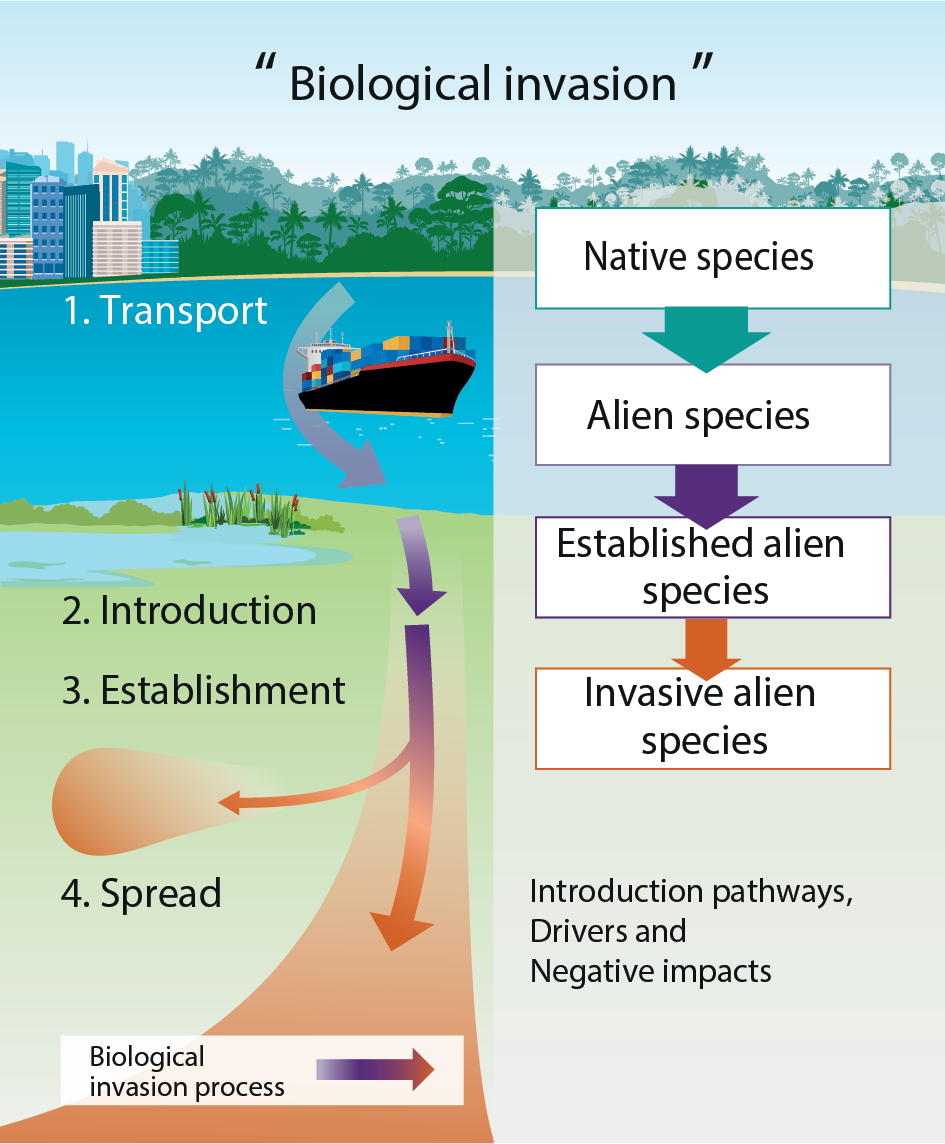
Click on an area to display text here.
More than 37,000 alien species, including more than 3,500 invasive alien species, have been recorded worldwide. The threats from biological invasions are increasing markedly across all regions, with the current unparalleled rate of introductions predicted to rise even higher in the future. Impacts of invasive alien species can occur long after first introduction, and currently observed threats from invasive alien species can lead to an underestimation of the magnitude of the future impacts.
The total numbers of established alien species in the 18 IPBES subregions and their temporal trends from 1500 to 2015 for the four IPBES regions are shown below for each taxa.
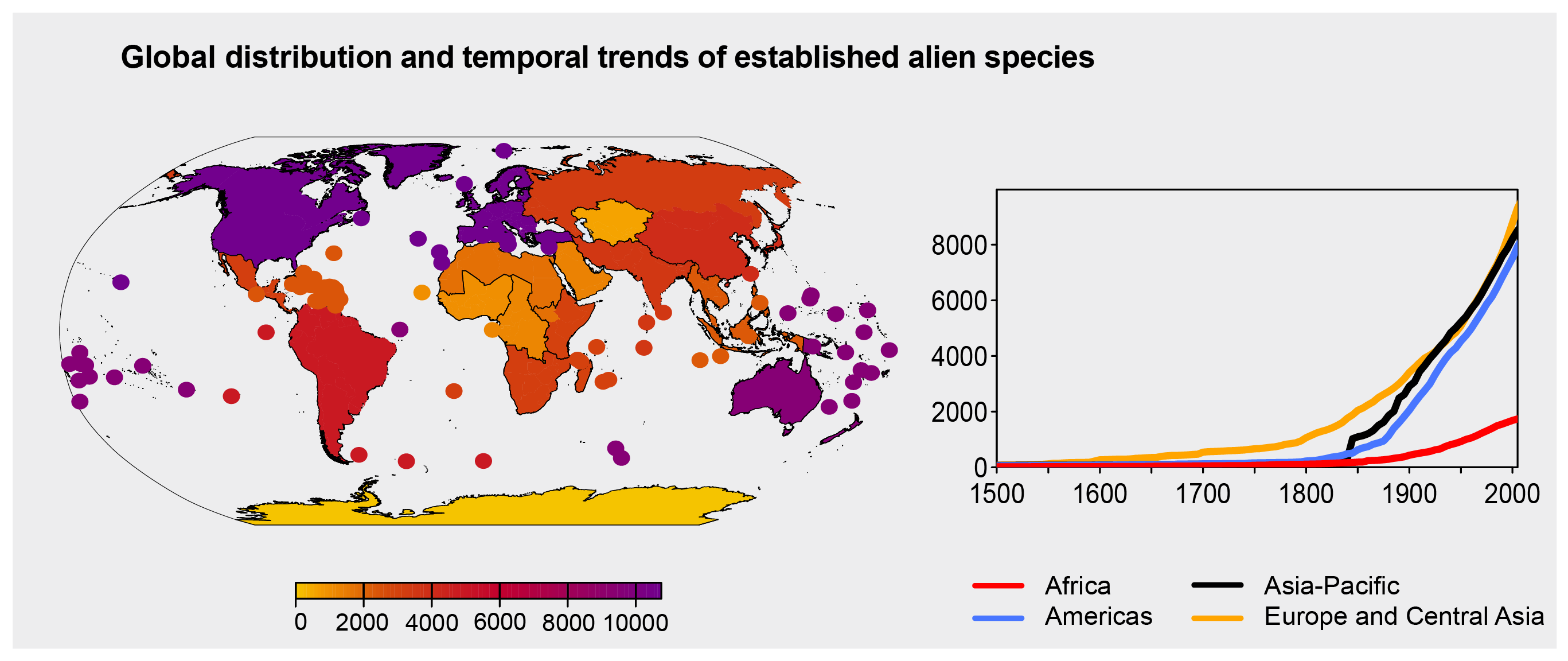
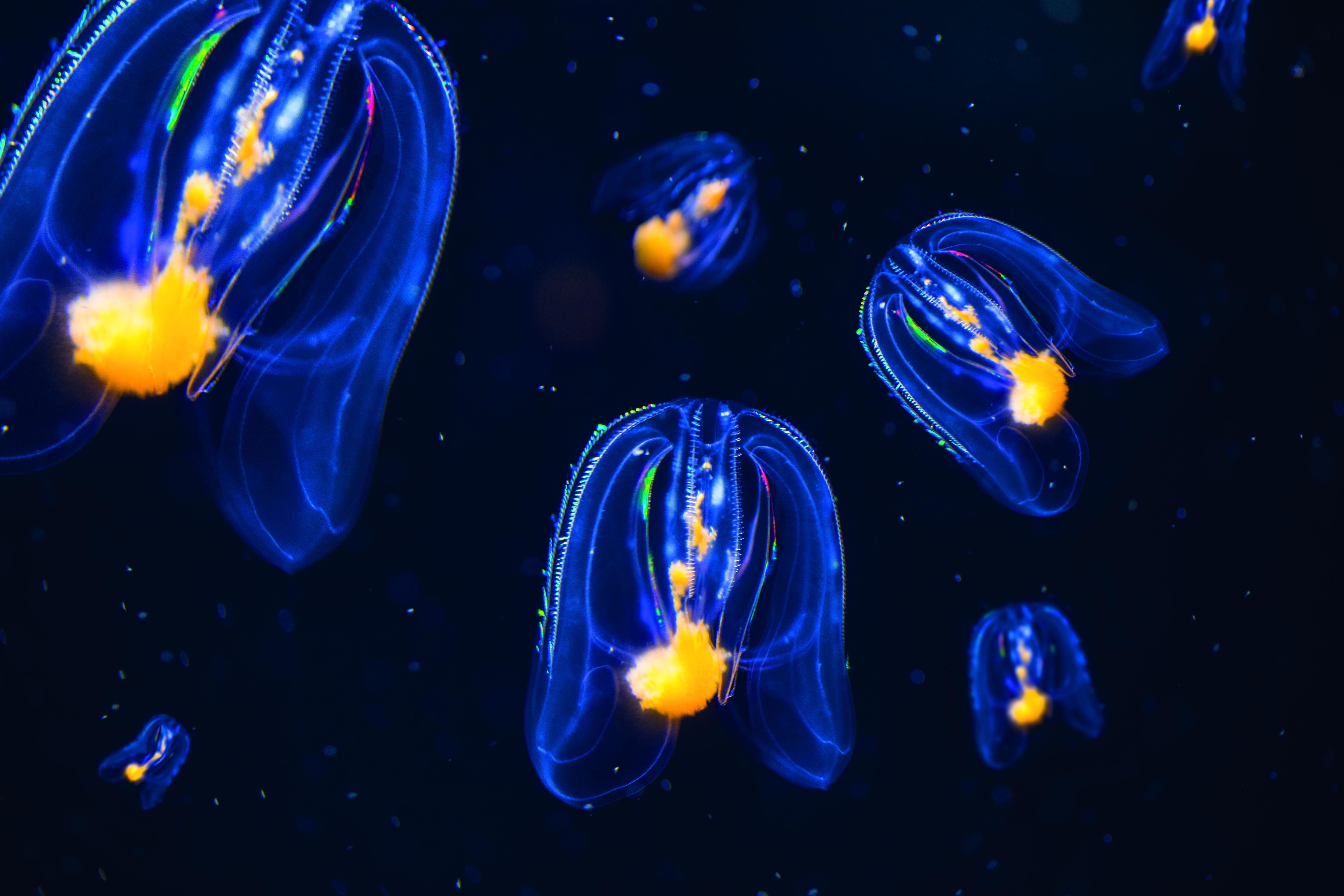
Drivers
influencing the transport, introduction, establishment and spread of invasive alien species
Whether intentionally or not, many human activities facilitate biological invasions around the world. The ongoing amplification of drivers of biodiversity change may greatly increase the number of invasive alien species and their impacts in the future. Climate change, interacting with land- and sea-use change, is predicted to profoundly shape and amplify the future threat from biological invasions.
Indirect drivers
Indirect drivers of change include economic, sociocultural, demographic, policies, governance and institutions, as well as science and technology.
Transport Introduction Establishment Spread
Economic+
International trade (whether legal or illegal) in commodities is an important route through which invasive alien species are introduced into new regions. Clearly, the more locations at which international commodities first arrive in a country, the greater the likelihood that invasive alien species will succeed in finding a suitable environment. Alien species may themselves be the imported commodity, or a contaminant of a commodity, or be associated with a transport vector as a stowaway. There is often a strong correlation between the number of alien species in a country and the value of commodity imports, supporting the view that international trade is a key driver in the introduction of invasive alien species. For the foreseeable future, rates of alien species introductions through trade will continue to increase, thus leading to pressure on national borders that may soon outstrip the resources available for intervention.
Transport
Introduction
Establishment
Spread
Sociocultural and social values+
The role of hunters intentionally spreading game animals: introduction for hunting accounts for a large proportion of intentional introductions of invasive alien birds and mammals, both in absolute numbers and compared to introductions for biological control, pet trade, and use of fur. High rates of introduction and establishment can result from intensive human efforts to maintain sufficiently large and stable populations of alien species for hunting Introductions may also occur in cases where population sizes of traditionally-used native species have significantly reduced, and alien species are then introduced to supplement hunting or fishing. Alien species are still released for hunting purposes in Europe, but the rate of new species introduced has been declining over the past 10 years as the knowledge that alien species have negative effects on native ecosystems has increased.
Transport
Introduction
Establishment
Spread
Demographic+
Migrating humans act as direct dispersal vectors in the transport and spread of plants, animals, and microbes, either unintentionally in the case of pests and diseases or intentionally in the case of pets, livestock, ornamentals, or crops. Generally, broad-scale analyses of the spread and distribution of alien species find links between the rate and origins of introductions of new species and human migration history. Likewise, several studies reveal close congruence of intraspecific genetic patterns with historical large-scale human migration. Nevertheless, other movements of people and goods around the globe are increasing more rapidly than migration, so that the relative importance of human migration per se in the introduction of invasive alien species is therefore likely to be decreasing.
Transport
Introduction
Establishment
Spread
Policies, governance and institutions+
International funding agencies: International funding agencies for economic development and regional integration may indirectly influence the uptake, and transport of invasive alien species by financing large scale infrastructure that facilitates the unintended movement of alien species. In addition, international funding agencies may facilitate the introduction, release, and establishment of invasive alien species by actively promoting the use of alien species in agriculture, fisheries and forestry and carbon sequestration solutions. More generally, international aid and assistance programmes have actively promoted the use of farmed plants, fish, and animals in new regions, many of which are invasive and/or are hosts of other invasive alien species.
Transport
Introduction
Establishment
Spread
Science and technology+
Breeding technologies: The modification of phenotypic traits can increase the invasion potential of species that otherwise would not be invasive. Plant and animal traits that have traditionally been modified through breeding, selection, and hybridization can now be more effectively modified via genomic technologies. There is good evidence that traditional breeding of plant species native to other regions for ornamental purposes has increased their invasive potential in North America. Likewise, there is concern that the invasive potential of some pasture grasses has increased as a result of intensive artificial selection. Among vertebrate invasions, intensive artificial selection has increased the fecundity of domestic pigs, so that hybridization and admixture between populations of domesticated pigs and wild boar have been associated with feral swine genotypes more likely to establish and spread in natural ecosystems.
Transport
Introduction
Establishment
Spread
Direct drivers
Direct drivers of change include land- and sea-use change, climate change, pollution, direct exploitation of organisms, alongside invasive alien species.
Land-/sea-use change+
Forage production and livestock grazing: Management of pastures for domestic herbivores is a major source of biological introductions, because species sown or planted for forage, or weeds associated with these land-uses, may escape and spread into natural ecosystems. It was shown that 91 per cent of grasses developed by agribusiness for pasture were listed as weeds somewhere in the world, and often in the same countries where they were actively been developed and marketed. Policies aiming to facilitate pastoral development can also be responsible for introductions, and several of these economically important pasture grasses are invasive alien species throughout several countries, some of them also acting as hosts of invasive pathogens.
Transport
Introduction
Establishment
Spread
Climate change+
Temperature change: The general expectation is that with increasing temperatures, some established alien species will be able to expand their ranges polewards and to high elevations and thus expand their introduced ranges without additional human assistance. Climate change may increase the probability of establishment and spread of alien species that are currently present in a particular region in anthropogenic environments such as buildings, glasshouses, and gardens but are limited by climate from surviving in nature. Several empirical studies support and confirm some of these projections. Higher temperatures, extended summer seasons, and increasing available thermal budget for growth are recognized as potential explanations for ongoing polewards shifts in species’ distributions. Likewise, there is evidence that alien species may be especially well-suited to exploit opportunities for range expansions offered by warming.
Transport
Introduction
Establishment
Spread
Pollution+
Marine debris: The burgeoning amount of plastic debris in the ocean (14 million tons per year) has created unprecedented opportunities for the dispersal of marine organisms through rafting, representing a potential mechanism for biological invasions. Floating marine debris can disperse attached organisms significant distances depending on the ocean current speed and direction, and thus facilitates first introductions (via long-distance transport) to a new region, and secondary spread (short-distance transport) within an invaded region. Floating plastic degrades much more slowly than natural rafting material and often hosts an extensive and reproductively active fouling biota, before becoming part of marine floating litter. Marine debris can interact with other drivers in facilitating biological invasions. Notably, natural disasters can enhance the movement of invasive alien species traveling on marine debris.
Transport
Introduction
Establishment
Spread
Extraction of natural resources+
Introductions of aquatic and marine species for fisheries and angling purposes: Intentional release of fishes and other marine organisms into rivers, lakes, and seas to enhance recreational fishing as well as livelihoods is both widespread and common. Globally, hatchery-reared juveniles of more than 180 species of fish and shellfish have been released in the wild for various purposes, including replacing locally extinct stocks (restocking), augmenting a viable fishery (stock enhancement), and creating new fisheries (sea ranching). As many of these releases are occurring at massive scales either outside the native distribution of the species or facilitating spread outside the native range, this constitutes a substantial pathway for aquatic introductions. Introductions, unintentional as well as intentional (e.g., live bait) and legal as well as illegal, have led to the establishment and spread of alien species in freshwater systems in Europe, North America, South America, South Africa, and Oceania.
Transport
Introduction
Establishment
Spread
Invasive alien species+
Biotic facilitation: Invasive alien species can facilitate the establishment and spread of other invasive alien species through multiple direct and indirect ecological interactions. Direct biotic facilitation often involves plant-animal interactions (e.g., pollination), dispersal, plant-fungal interactions (e.g., mycorrhizal symbiosis), or animal-animal (e.g., ant-scale insect) mutualisms, or even multitrophic interactions like those between alien herbivores dispersing alien fungi (e.g., mycorrhiza of alien trees). However, alien species may also indirectly facilitate the establishment and spread of other invasive alien species, by modifying the biotic conditions of the recipient community (e.g., reducing competition or predation pressure by a third species, or increasing food resource availability), or abiotic attributes and ecosystem properties. Evidence points to biotic facilitation among alien species as a major driver of the establishment and spread of invasive alien species. However, there are some exceptions to this general pattern, as well as biases and gaps.
Transport
Introduction
Establishment
Spread
Other drivers
The assessment also considers how biological invasions, and ultimately the impacts of invasive alien species, can be facilitated by biodiversity loss itself and by natural drivers of change, in particular natural hazards (such as floods, storms and wildfires).
Biodiversity loss+
Biodiversity loss and ecosystem resilience: A wide range of biotic interactions may confer resistance to biological invasions in native communities, and all of these may be involved in constraining the introduction, establishment, and spread of invasive alien species. Therefore, biodiversity loss can also be seen as a driver of invasive alien species since reduced taxonomic or functional diversity of native ecosystems may reduce their biotic resistance and thereby facilitate biological invasions. Studies from terrestrial systems show that the presence and diversity of native vegetation can constrain plant invasions, implicating different modes of plant-plant competition for space as a powerful mechanism underlying biotic resistance to biological invasion. Marine experiments revealed the same general trend; high native primary producer diversity in marine systems confers significant resistance to biological invasions of alien primary producers through competition, whereas low-diversity communities in the same marine systems often fail to do so.
Transport
Introduction
Establishment
Spread
Natural drivers+
Natural drivers of change: Natural large-scale disturbances, such as hurricanes, earthquakes and tsunamis can facilitate the onward spread of alien species from an existing invaded range to new regions as well as encourage their wider spread within regions where they are already present as aliens. Natural disturbances such as hurricanes have played a role in assisting the dispersal of alien animals, plants, and microbes, leading to expansion of their historical invaded ranges. Known cases illustrate the capacity of natural drivers to facilitate colonization events, but also suggest an increasing influence of anthropogenic climate change as an amplifier of such dispersal opportunities. The relative importance of natural drivers such as natural hazards in the range dynamics of alien species, however, are likely to be relatively minor. Natural long-distance dispersal events have evidently been sufficient to colonize remote oceanic islands in the prehistoric past, but are likely orders of magnitude less frequent than human-assisted, long-distance dispersal events.
Transport
Introduction
Establishment
Spread
Direct and indirect drivers have been identified in the IPBES Global Assessment Report on Biodiversity and Ecosystem Services (IPBES, 2019)
People and nature are threatened by invasive alien species in all regions of Earth. Biological invasions cause dramatic and, in some cases, irreversible changes to ecosystems resulting in adverse and complex outcomes, including local and global species extinctions. The economy, food security, and human health are profoundly affected by biological invasions. Biological invasions can result in marginalization and inequity, including, in some contexts, gender- and age-differentiated impacts.
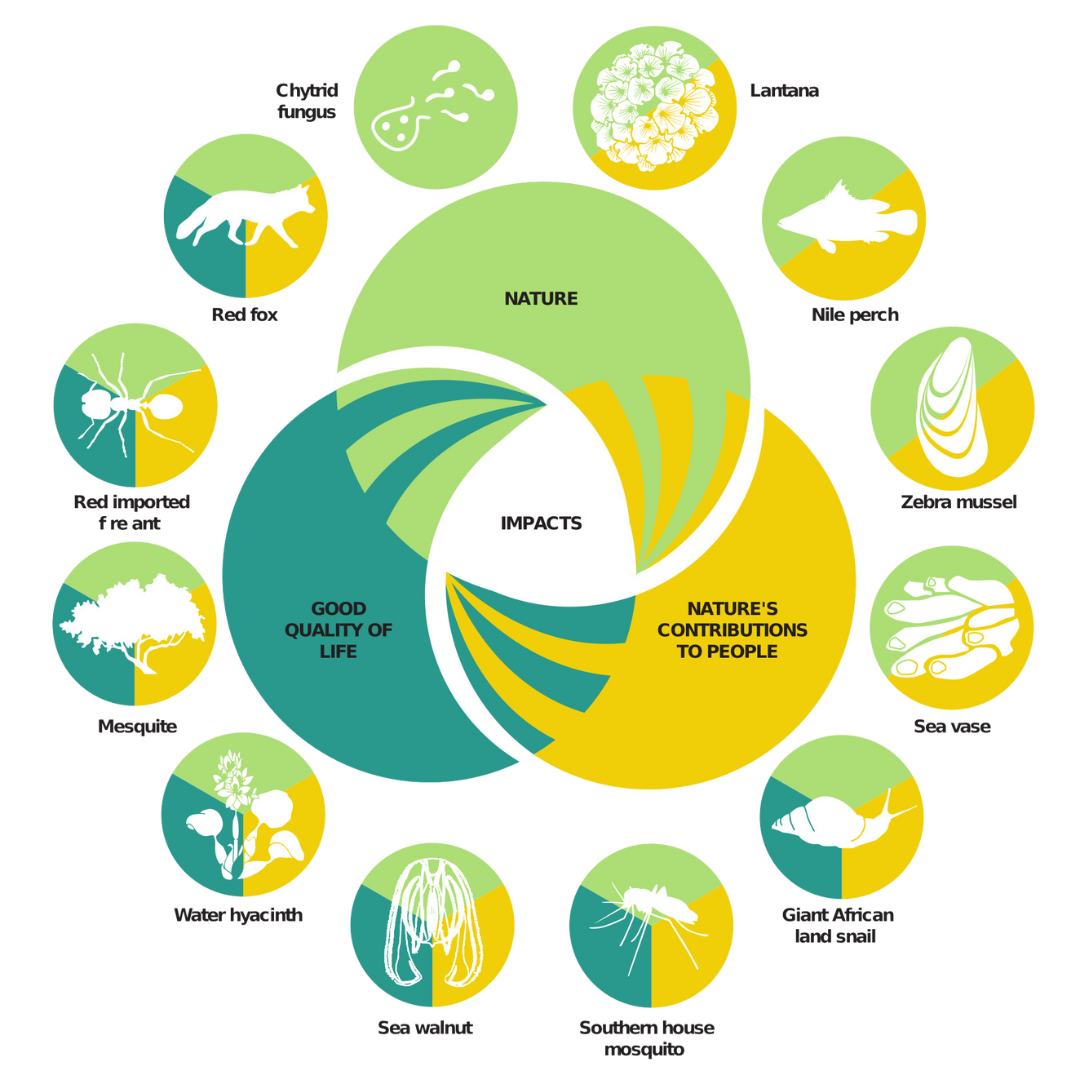
Click on an area to display text here.

The number and impact of invasive alien species can be reduced through management of biological invasions. Prevention and preparedness are the most cost-effective options but other management options can also be effective. There are 3 management targets:
- Prevention through management of pathways of introduction and spread of invasive alien species;
- Management of target invasive alien species at either local or landscape scales; and
- Site-based or ecosystem-based management
Engagement and collaboration with stakeholders and Indigenous Peoples and local communities improves outcomes of management actions for biological invasions, particularly where there are conflicting perceptions of the value of invasive alien species or the ethics of management options. Management actions also benefit from sharing and collaboration across knowledge systems.

Click on an area to display text here.
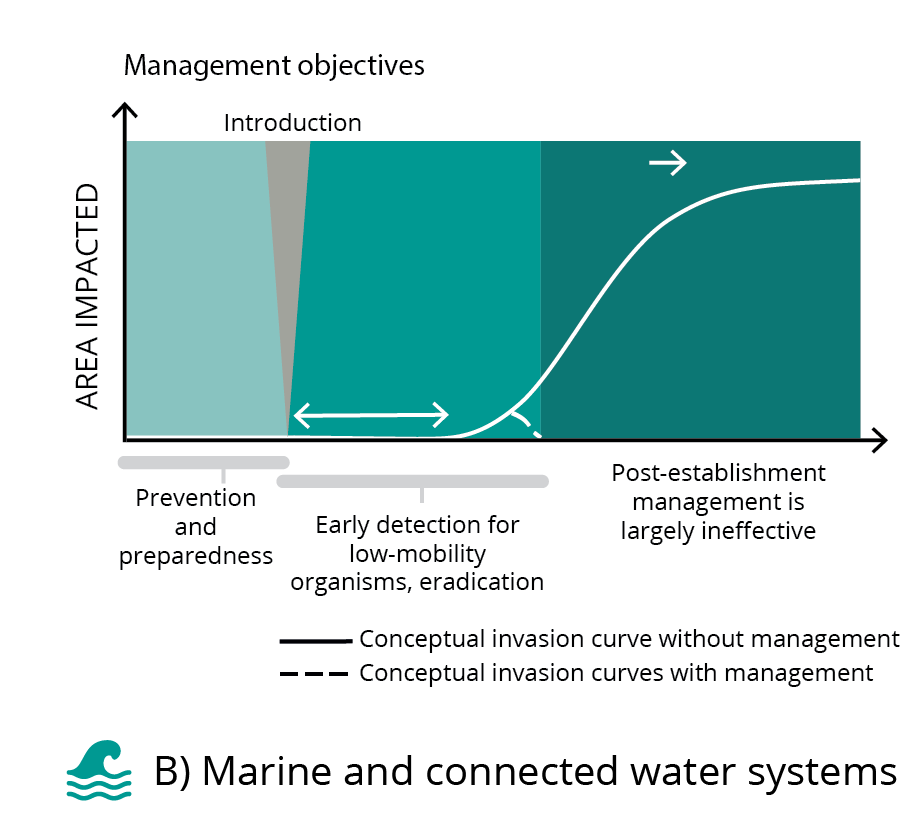
Click on an area to display text here.

The number and impact of invasive alien species can be reduced through management of biological invasions. Prevention and preparedness are the most cost-effective options for managing the threats from biological invasions. Stakeholder engagement and collaboration with Indigenous Peoples and local communities improve outcomes of management actions for biological invasions.
What is Integrated governance for biological invasions?
An approach that establishes the relationships between all actors, institutions and instruments involved in biological invasions and their management, to identify the strategic interventions needed to improve invasive alien species prevention and control outcomes.

Click on an area to display text here.